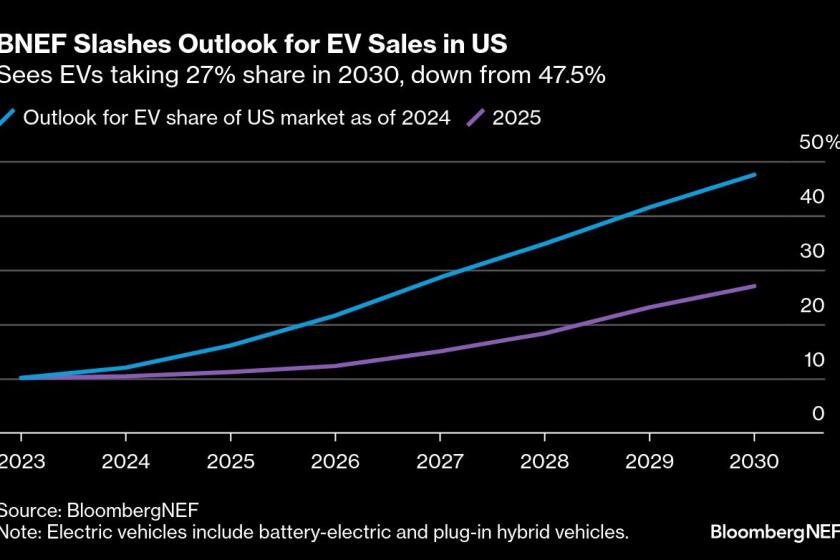Ford Motor Co. Starts Up Its Own Plant in Russia
- Share via
MOSCOW — Ford Motor Co. officially launched the first fully foreign-owned automotive plant in Russia on Tuesday, a precedent that experts hope will pave the way for other global businesses to set up manufacturing here.
The new $150-million plant outside St. Petersburg, which initially will employ 400 production workers and 400 support staff, is a signal to other manufacturers that Russia has emerged from the economic downturn of the late 1990s and is safe for direct foreign investment, officials and analysts said.
“We have a big fleet of 40 cars now on the street,” declared Henrik Nenzen, a Swede who is president of Ford Russia. The vehicles are being tested and evaluated, he said, with the first Russian-built Fords making their way to consumers by late September.
Ford, the world’s No. 2 auto maker, is not the only U.S. car company eyeing the Russian market.
General Motors Corp. has entered into a $300-million investment with Russia’s AvtoVAZ. GM is helping AvtoVAZ produce an upgraded Niva sport-utility vehicle in the Samara region of southern Russia. The vehicle will be marketed under the Chevrolet brand name.
Russians have long complained that the West has been quick with advice and promises but slow with direct investment, especially outside the oil-and-gas industry.
In that sense, the Ford opening “is a really great event for the country,” said Nina Oding, a senior analyst at St. Petersburg’s Leontief Economic Research Institute, because it offers new industrial growth and employment. “We are talking here about direct investment, not simply some form of credits like our governors enjoy bragging about.
“This means an exchange of technology and production and administrative discipline--things important for Russia now,” she added. “It also creates jobs for workers dreaming of good and stable pay, a workable system of bonuses and other benefits.”
Line workers will make the equivalent of $220 a month, and skilled engineers up to $600, Nenzen said. For that pay level, Ford turned away many applicants and was able to put together a highly educated, dedicated work force, he said. The average monthly wage in Russia is $134, according to the World Bank.
The Ford plant is in Vsevolozhsk, about 15 miles northeast of downtown St. Petersburg. It is believed to be the first case of a foreign company setting up a large industrial factory in the country without Russian partners. Nenzen stressed that it is not simply an assembly plant, putting together nearly completed portions of automobiles, imported from elsewhere, but a full-fledged factory with its own body welding, paint and final assembly sections.
Despite reports of stifling bureaucracy and corruption on the Russian business scene, Nenzen said, Ford’s experience was no more or less difficult than inaugurating a plant in any other European country. “The building here started to be built in the summer of 2000. So it is not a long period,” he noted.
The plant will manufacture four-door, hatchback and station wagon versions of the popular Ford Focus. Since the vehicles will be made in Russia, the company will not have to pay the 25% duty applied to imported cars.
“Our prices will become much, much more attractive, and our sales volume will go up,” Nenzen said.
The plant is able to produce 25,000 cars a year with a potential for further expansion to 100,000. Cars made in Russia will be priced from about $10,900, compared with nearly $14,000 if imported.
In exchange for duty-free status, Ford agreed to make sure that 50% of the car components come from Russia within five years, meaning the plant will have a ripple benefit for the Russian economy. So far, the Russian component portion of each car totals only 20%, taking into account plant investment and labor. Russian firms supply only the glass, seats and trim for the cars rolling off the lines currently.
Nenzen said Ford decided to build the factory in 1999, just months after Russia’s 1998 currency collapse and economic crisis. “The Ford board was convinced that in the long term this very, very large country with a lot of inhabitants would have a strong automotive market with a lot of consumers,” he said. “I think others will come after.”
About 1.5 million new and used cars are bought in Russia each year. About 1 million of those are Russian cars, with new models selling for $5,000 to $8,000. About 95,000 are imported new cars. The rest are imported used cars, mainly from Germany.
Given the size of the market and their paltry share, global car makers such as Ford and GM see Russia as one of the last large untapped markets for their products.
Since the collapse of the Soviet Union a decade ago, Western energy companies have committed billions of dollars to help develop Russia’s vast oil-and-gas resources, and there also have been some investments in food processing products sold to Russian consumers.
But few have moved into industrial manufacturing, which is still dominated by post-Communist enterprises, many of which have laid off workers and are still struggling to adjust to free-market conditions.
Sergei L. Loiko of The Times’ Moscow Bureau contributed to this report.






